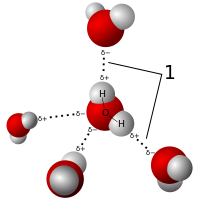
Protein Design with Fluoroprolines: 4,4‐Difluoroproline Does Not Eliminate the Rate‐Limiting Step of Thioredoxin Folding
Sign Up to like & getrecommendations! Published in 2021 at "ChemBioChem"
DOI: 10.1002/cbic.202100418
Abstract: C4‐substituted fluoroprolines (4R)‐fluoroproline ((4R)‐Flp) and (4S)‐fluoroproline ((4S)‐Flp) have been used in protein engineering to enhance the thermodynamic stability of peptides and proteins. The electron‐withdrawing effect of fluorine can bias the pucker of the pyrrolidine ring,… read more here.
Keywords: rate limiting; protein design; rate; peptide bond ... See more keywords

Uncatalyzed peptide bond formation between two double amino acid molecules in the gas phase
Sign Up to like & getrecommendations! Published in 2017 at "International Journal of Quantum Chemistry"
DOI: 10.1002/qua.25435
Abstract: The gas phase mechanism for peptide bond formation between two double amino acid (DAA) molecules ((NH2)2C(COOH)2) is investigated in the absence of any catalysts. Two different paths, concerted and stepwise, each leading to both cis… read more here.
Keywords: bond; gas phase; peptide bond; bond formation ... See more keywords

Water-assisted peptide bond formation between two double amino acid molecules in the gas phase
Sign Up to like & getrecommendations! Published in 2019 at "Journal of Molecular Modeling"
DOI: 10.1007/s00894-019-4081-9
Abstract: The gas phase mechanism of the peptide bond formation between two double amino acid (DAA) molecules described by the (NH2)2C(COOH)2 formula is investigated in the presence of a water molecule. Formations of trans and cis… read more here.
Keywords: bond formation; water; formation two; peptide bond ... See more keywords

Substance P in Solution: Trans-to-Cis Configurational Changes of Penultimate Prolines Initiate Non-enzymatic Peptide Bond Cleavages
Sign Up to like & getrecommendations! Published in 2019 at "Journal of The American Society for Mass Spectrometry"
DOI: 10.1007/s13361-019-02159-w
Abstract: AbstractWe report ion mobility spectrometry and mass spectrometry studies of the non-enzymatic step-by-step degradation of substance P (subP), an 11-residue neuropeptide, with the sequence Arg1-Pro2-Lys3-Pro4-Gln5-Gln6-Phe7-Phe8-Gly9-Leu10-Met11-NH2, in ethanol. At elevated solution temperatures (55 to 75 °C),… read more here.
Keywords: bond; trans cis; peptide bond; non enzymatic ... See more keywords

Prolyl 4-Hydroxylase: Substrate Isosteres in Which an (E)- or (Z)-Alkene Replaces the Prolyl Peptide Bond.
Sign Up to like & getrecommendations! Published in 2017 at "Biochemistry"
DOI: 10.1021/acs.biochem.6b00976
Abstract: Collagen prolyl 4-hydroxylases (CP4Hs) catalyze a prevalent posttranslational modification, the hydroxylation of (2S)-proline residues in protocollagen strands. The ensuing (2S,4R)-4-hydroxyproline residues are necessary for the conformational stability of the collagen triple helix. Prolyl peptide bonds… read more here.
Keywords: prolyl; prolyl peptide; prolyl hydroxylase; peptide bond ... See more keywords

Diboronic Acid Anhydride-Catalyzed Direct Peptide Bond Formation Enabled by Hydroxy-Directed Dehydrative Condensation.
Sign Up to like & getrecommendations! Published in 2020 at "Organic letters"
DOI: 10.1021/acs.orglett.0c03252
Abstract: We report the catalytic direct peptide bond formations via dehydrative condensation of β-hydroxy-α-amino acids, affording the serine, threonine, or β-hydroxyvaline-derived peptides in high to excellent yields with high functional group tolerance, minimum epimerization, and excellent… read more here.
Keywords: hydroxy directed; diboronic acid; acid anhydride; dehydrative condensation ... See more keywords

Facile Peptide Bond Formation: Effective Interplay between Isothiazolone Rings and Silanol Groups at Silver/Iron Oxide Nanocomposite Surfaces
Sign Up to like & getrecommendations! Published in 2019 at "ACS Omega"
DOI: 10.1021/acsomega.9b00986
Abstract: Proportional to considerable progress in protein–drug conjugations, attention to the efficient peptide coupling reagents is being increased. Hence, in this study, a versatile heterogeneous nanoscale reagent is presented for chemical, biological, and medical purposes. A… read more here.
Keywords: iron oxide; bond formation; isothiazolone rings; peptide bond ... See more keywords

Peptide Bond of Aqueous Dipeptides Is Resilient to Deep Ultraviolet Irradiation.
Sign Up to like & getrecommendations! Published in 2023 at "Journal of the American Chemical Society"
DOI: 10.1021/jacs.3c01469
Abstract: The susceptibility of aqueous dipeptides to photodissociation by deep ultraviolet irradiation is studied by femtosecond spectroscopy supported by density functional theory calculations. The primary photodynamics of the aqueous dipeptides of glycyl-glycine (gly-gly), alalyl-alanine (ala-ala), and… read more here.
Keywords: peptide bond; aqueous dipeptides; deep ultraviolet; ultraviolet irradiation ... See more keywords

Origins of the Mechanochemical Coupling of Peptide Bond Formation to Protein Synthesis.
Sign Up to like & getrecommendations! Published in 2018 at "Journal of the American Chemical Society"
DOI: 10.1021/jacs.7b11044
Abstract: Mechanical forces acting on the ribosome can alter the speed of protein synthesis, indicating that mechanochemistry can contribute to translation control of gene expression. The naturally occurring sources of these mechanical forces, the mechanism by… read more here.
Keywords: protein; peptide bond; force; bond formation ... See more keywords

Gold(I)-Mediated Decaging or Cleavage of Propargylated Peptide Bond in Aqueous Conditions for Protein Synthesis and Manipulation.
Sign Up to like & getrecommendations! Published in 2020 at "Journal of the American Chemical Society"
DOI: 10.1021/jacs.9b13216
Abstract: Chemists have been interested in N-alkylation of the peptide bond since such a modification alters the conformation of the amide bond, interferes with hydrogen bond formation and changes other properties of the peptide (e.g. solubility).… read more here.
Keywords: bond; aqueous conditions; peptide bond; protein synthesis ... See more keywords

Revisiting the concept of peptide bond planarity in an iron-sulfur protein by neutron structure analysis
Sign Up to like & getrecommendations! Published in 2022 at "Science Advances"
DOI: 10.1126/sciadv.abn2276
Abstract: The planarity of the peptide bond is important for the stability and structure formation of proteins. However, substantial distortion of peptide bonds has been reported in several high-resolution structures and computational analyses. To investigate the… read more here.
Keywords: planarity; structure; peptide bond; neutron structure ... See more keywords